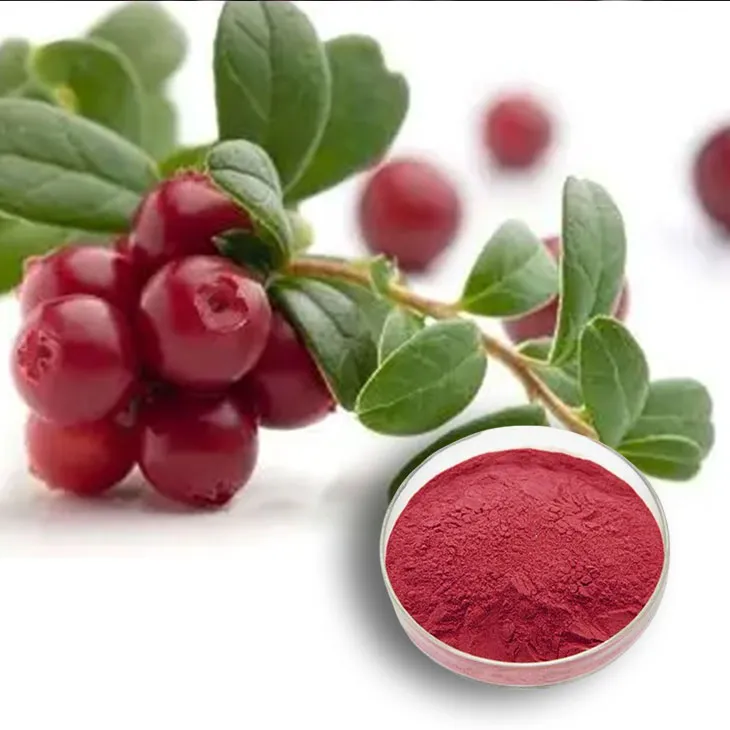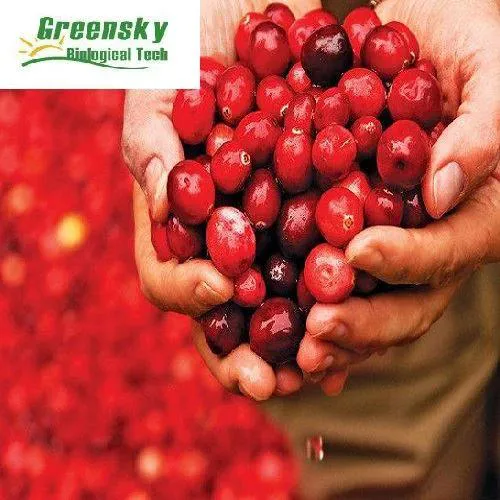- 0086-571-85302990
- sales@greenskybio.com
The extraction process of cranberry extract.
2024-11-29

1. Introduction
Cranberry Extract has gained significant popularity in recent years due to its numerous health benefits. It is rich in various bioactive compounds, such as proanthocyanidins, flavonoids, and organic acids. These compounds are associated with positive effects on urinary tract health, antioxidant activity, and anti - inflammatory properties. The extraction process of Cranberry Extract is crucial to obtain a high - quality product with a high concentration of these beneficial compounds.

2. Raw Material Selection
High - quality cranberries are the foundation of a good extract.
- Cranberries are carefully sourced from reliable growers. The selection process takes into account factors such as the variety of cranberries, their ripeness, and the absence of diseases or pests.
- Only cranberries that meet strict quality standards are chosen for the extraction process. This ensures that the final extract will have a consistent composition and high potency.

3. Washing
Thorough washing is an essential step to remove impurities.
- The selected cranberries are first rinsed with clean water. This helps to eliminate dirt, debris, and any surface contaminants that may be present on the berries.
- Special attention is given to ensure that all parts of the cranberries are clean. Sometimes, gentle agitation may be used during the washing process to dislodge any stubborn impurities.
- After washing, the cranberries are drained to remove excess water. This is important as excess water can affect the subsequent extraction steps.

4. Pretreatment: Crushing or Grinding
Breaking down the cranberry structure aids in extraction.
- Once the cranberries are clean and dry, they may be subjected to crushing or grinding. Crushing can be done using mechanical crushers, which apply pressure to break the berries into smaller pieces.
- Grinding, on the other hand, can produce a finer texture. This can be achieved using grinders such as mortar and pestle or industrial - scale grinding machines.
- The degree of crushing or grinding may vary depending on the extraction method to be used. A finer texture may be preferred for some extraction methods as it increases the surface area available for extraction.

5. Extraction Methods
Different extraction methods are available, with solvent extraction being commonly used.
5.1 Solvent Extraction
-
Solvent selection
- Ethanol is a popular solvent for Cranberry Extraction. It has the ability to dissolve many of the bioactive compounds present in cranberries, such as proanthocyanidins and flavonoids.
- Water - ethanol mixtures can also be used. These mixtures can offer advantages in terms of selectivity and solubility. For example, a certain ratio of water to ethanol may be more effective in extracting specific compounds while minimizing the extraction of unwanted substances.
-
Extraction process
- The crushed or ground cranberries are mixed with the selected solvent. This is usually done in a closed vessel to prevent solvent evaporation.
- The mixture is then stirred or agitated for a certain period. This helps to ensure that the solvent comes into contact with all parts of the cranberry material, facilitating the dissolution of the desired compounds.
- The extraction time can vary depending on factors such as the type of cranberries, the solvent used, and the desired concentration of the extract. It can range from a few hours to several days.
5.2 Other Extraction Methods
- Supercritical fluid extraction is another method that can be considered. In this method, supercritical fluids such as carbon dioxide are used as solvents. Supercritical carbon dioxide has properties that make it an effective solvent for extracting bioactive compounds. It can offer advantages such as a mild extraction process, which can preserve the integrity of the compounds, and easy solvent removal after extraction.
- Pressurized liquid extraction is also possible. This method uses high - pressure liquid solvents to extract compounds from cranberries. It can be a more efficient method in terms of extraction time and solvent consumption compared to traditional solvent extraction methods.
6. Filtration
Filtration is necessary to separate the liquid extract from solid residues.
- After the extraction process, the resulting mixture contains the liquid extract with the dissolved bioactive compounds and solid residues such as cranberry pulp and cell debris.
- Filtration can be carried out using various types of filters. For example, filter papers can be used for small - scale filtrations. In industrial settings, more advanced filtration systems such as membrane filters or vacuum filters may be employed.
- The filtered liquid extract is then collected. This liquid contains the active substances that are of interest for the production of cranberry extract.
7. Concentration
Concentration enhances the potency of the cranberry extract.
- The filtered liquid extract may be concentrated through evaporation. This can be achieved by heating the extract under controlled conditions. The solvent, usually ethanol or water - ethanol mixtures, is evaporated, leaving behind a more concentrated extract.
- Vacuum evaporation can be used to reduce the boiling point of the solvent, which helps to prevent the degradation of the bioactive compounds during the concentration process. This method is particularly useful for heat - sensitive compounds.
- The final concentrated cranberry extract is rich in beneficial compounds such as proanthocyanidins. This concentrated extract can then be further processed, such as being formulated into dietary supplements or used in the food and beverage industry.
8. Quality Control
Quality control measures are implemented throughout the extraction process.
- Analysis of the raw cranberries is carried out to ensure that they meet the required quality standards. This includes tests for factors such as the content of bioactive compounds, moisture levels, and the presence of contaminants.
- During the extraction process, parameters such as extraction time, solvent concentration, and temperature are closely monitored. Any deviation from the optimal values can affect the quality of the final extract.
- After the extraction and concentration steps, the final cranberry extract is analyzed for its composition, purity, and potency. This helps to ensure that the product meets the specifications for its intended use, whether it is for dietary supplements, pharmaceuticals, or other applications.
9. Conclusion
The extraction process of cranberry extract involves multiple steps, from raw material selection to final quality control. Each step is crucial in obtaining a high - quality extract rich in beneficial bioactive compounds. With the increasing demand for cranberry - based products, continuous research and improvement in the extraction process are essential to ensure the production of safe, effective, and high - quality cranberry extracts.
FAQ:
What are the key steps in the extraction process of cranberry extract?
The key steps include careful selection of high - quality cranberries, thorough washing to remove impurities, crushing or grinding the cranberries, using solvent extraction (such as with ethanol or water - ethanol mixtures), filtering the resulting solution to separate the liquid extract from solid residues, and finally concentrating the extract through evaporation.
Why is it necessary to wash cranberries before extraction?
It is necessary to wash cranberries before extraction to remove impurities like dirt and debris. These impurities can contaminate the extract and may also interfere with the extraction process or the quality of the final product.
What are the common solvents used in cranberry extract extraction?
The common solvents used in cranberry extract extraction are ethanol or water - ethanol mixtures. These solvents are effective in dissolving the desired active components from the cranberry pulp.
How is the active compound in cranberry extract obtained after filtration?
After filtration, the liquid extract containing the active substances is separated from the solid residues. This liquid extract already contains the active compound. If further concentration is needed, evaporation can be used to obtain a more potent cranberry extract rich in active compounds like proanthocyanidins.
What are the health - promoting properties of the compounds in cranberry extract?
Compounds in cranberry extract, such as proanthocyanidins, are known for their health - promoting properties in areas such as urinary tract health. They may help prevent certain urinary tract infections by inhibiting the adhesion of bacteria to the urinary tract walls.
Related literature
- Cranberry Extract: Composition, Properties, and Health Benefits"
- "The Science Behind Cranberry Extract Production"
- "Extraction Techniques for Bioactive Compounds in Cranberries"
- ▶ Hesperidin
- ▶ Citrus Bioflavonoids
- ▶ Plant Extract
- ▶ lycopene
- ▶ Diosmin
- ▶ Grape seed extract
- ▶ Sea buckthorn Juice Powder
- ▶ Fruit Juice Powder
- ▶ Hops Extract
- ▶ Artichoke Extract
- ▶ Mushroom extract
- ▶ Astaxanthin
- ▶ Green Tea Extract
- ▶ Curcumin
- ▶ Horse Chestnut Extract
- ▶ Other Product
- ▶ Boswellia Serrata Extract
- ▶ Resveratrol
- ▶ Marigold Extract
- ▶ Grape Leaf Extract
- ▶ New Product
- ▶ Aminolevulinic acid
- ▶ Cranberry Extract
- ▶ Red Yeast Rice
- ▶ Red Wine Extract
-
Clove Powder
2024-11-29
-
Boswellia Serrata Extract
2024-11-29
-
Fenugreek Extract Powder
2024-11-29
-
Bilberry Extract
2024-11-29
-
Nettle leaf extract
2024-11-29
-
Feverfew Extract
2024-11-29
-
Giant Knotweed Extract
2024-11-29
-
Rose Hip Extract
2024-11-29
-
Black Rice Extract
2024-11-29
-
Dandelion Root Extract
2024-11-29





















